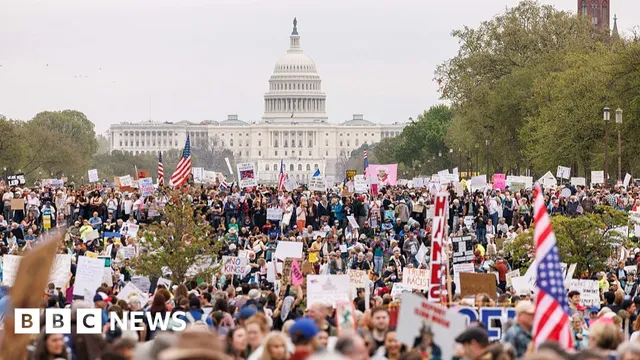
Thousands protest against Trump and his policies nationwide
2025-04-05 21:16- Protesters gathered in Washington, D.C., and across the U.S. in response to Trump’s policies.
- Events formed part of a larger global wave of dissent against Trump's administration.
- The demonstrations indicate a potential resurgence of political activism among opposing voters.
Express your sentiment!
Insights
On Saturday, thousands of individuals gathered on Washington's National Mall as well as in various cities across the United States to vocally oppose the policies of President Donald Trump. This surge of activism marked the largest protests since he assumed office again. Demonstrators held signs with slogans expressing their dissent, including 'Not My President!' and 'Fascism has Arrived.' Notably, Jane Ellen Saums, a 66-year-old real estate worker, dressed as Mother Nature to symbolize her alarm at the administration's dismantling of democratic values. The protests also mirrored sentiments observed in international cities like Paris and London. A coalition of left-leaning organizations, such as MoveOn and the Women’s March, coordinated the 'Hands Off' events in over 1,000 towns and congressional districts across the country. This wave of demonstrations stemmed from widespread outrage against Trump’s efforts to minimize government functions, enforce rigid conservative values, and apply pressure to trade agreements with foreign nations, resulting in detrimental impacts on stock market stability. Groups like Indivisible described Trump's administration as facilitating a significant power grab, exacerbating social tensions. The turnout on the National Mall included prominent voices from the Democratic Party. Activist Graylan Hagler emphasized the growing discontent, stating that the protests signify the awakening of a 'sleeping giant.’ Early estimates for the number of attendees suggested approximately 5,000 people convened for the event, a stark contrast to the massive Women's March that attracted half a million attendees shortly after Trump's election in 2016. Observers hope that this wave of activism reflects the increasing mobilization of voters against Trump’s agenda, especially as the midterm elections approach. Despite the protests and falling approval ratings for Trump, the administration has remained steadfast in its policies, with Trump dismissively stating that his approach would not be changing. The ongoing discontent may be critical in shaping the political landscape leading up to the next elections, marking a potential turning point in voter engagement as the opposition to Trump and his administration continues to grow.
Contexts
The protest against Donald Trump policies has become a significant aspect of the political landscape in recent years. Demonstrations have arisen in response to a variety of actions taken during his presidency, which many groups viewed as controversial or harmful. These protests often focused on key issues such as immigration policies, environmental deregulation, healthcare, and social justice. Activists mobilized through social media, public rallies, and grassroots organizations, highlighting not only their dissent but also advocating for alternative policies that align more closely with their values. One of the most notable protests occurred in 2017 following Trump's travel ban, which targeted several predominantly Muslim countries. This prompted widespread demonstrations at airports and major cities across the United States, with protesters chanting slogans and holding signs that emphasized their support for inclusivity and diversity. Similarly, subsequent immigration policies, such as the separation of families at the southern border, galvanized public outcry, leading to the formation of organizations dedicated to protecting the rights of immigrants and refugees. Environmental policies also sparked significant protest activity. The rollback of various environmental regulations and withdrawal from international agreements like the Paris Climate Accord ignited fierce opposition from environmental advocates. This culminated in large-scale events such as the Women's March and climate strikes, where thousands rallied to demand that the government take more decisive action against climate change and protect natural resources. These events often featured prominent speakers and activists who called for urgent change and highlighted the scientific consensus surrounding environmental issues. Social justice movements, particularly those related to racial equality, gained momentum during Trump's presidency, especially following incidents of police violence that received national attention. The Black Lives Matter movement, which advocates against systemic racism and police brutality, saw a resurgence of activism, culminating in massive protests during the summer of 2020. These movements not only addressed immediate grievances but also sought to foster a broader dialogue around racial equity, necessitating changes to policy at local and national levels. The cumulative effect of these protests has been to create a lasting impact on the political discourse in the U.S. and to influence upcoming elections as citizens advocate for a government that reflects their values and priorities.